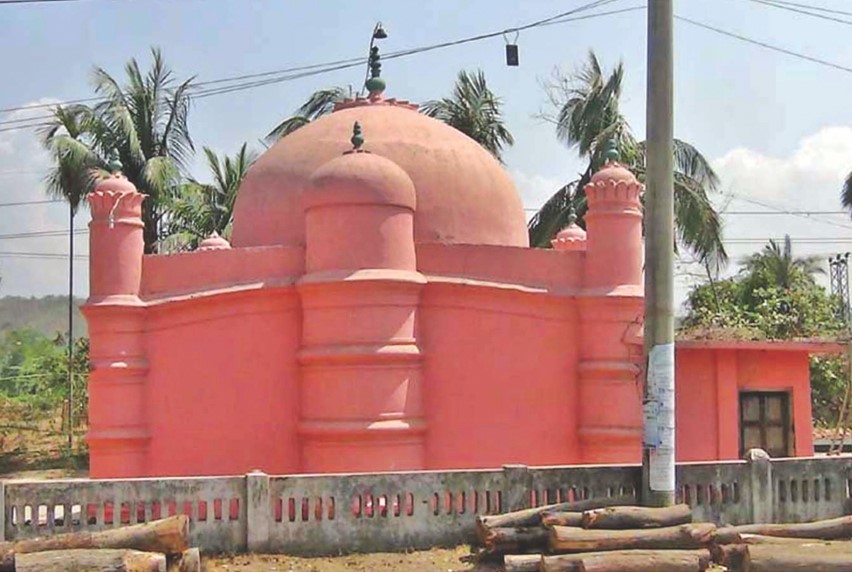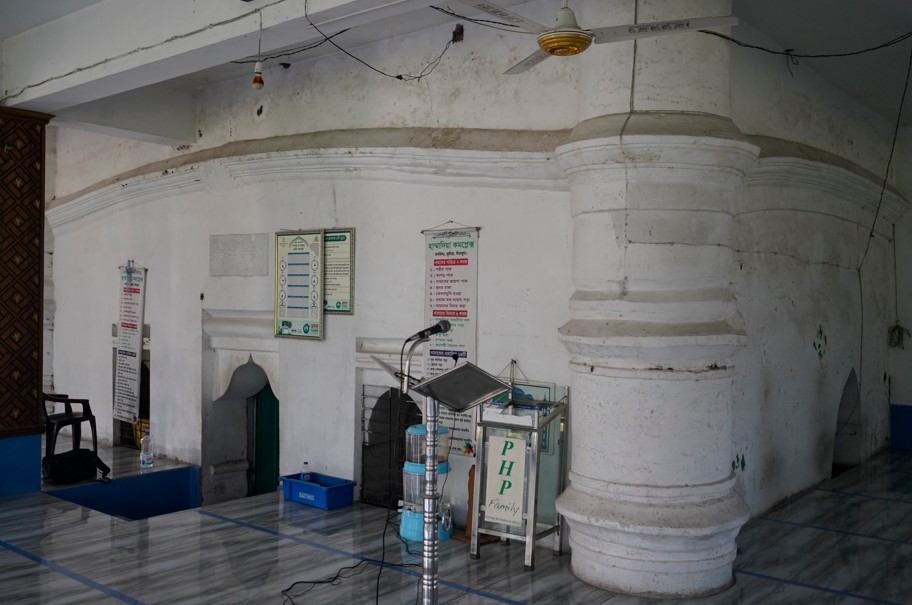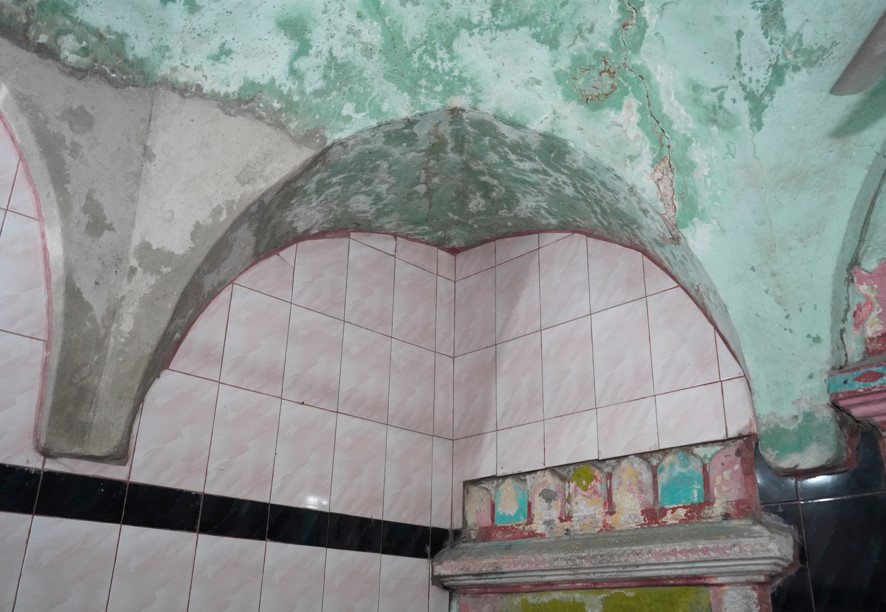
Hammadia Jame Mosque

Camera from extension

Inscription Over the Mihrab

Exit Main Gate

Internal Arch Pattern

Internal Arch Pattern for Dome

Top of Corner Tower
Introduction
The Hammadia Mosque, located in Sitakundu, Chittagong, is a historical and architectural landmark that dates back to the Mughal era. This mosque, known for its unique design and historical significance, represents the rich cultural and religious heritage of the region. Established in the 17th century, the Hammadia Mosque has stood the test of time, continuing to serve as a place of worship and a symbol of the Mughal architectural legacy in Bengal.
Historical Background
The Mughal Empire, renowned for its monumental architecture and cultural achievements, extended its influence to Bengal in the 16th and 17th centuries. The establishment of the Hammadia Mosque in Sitakundu during this period reflects the spread of Islam and the architectural patronage of the Mughal rulers. The mosque was likely built under the supervision of local Mughal authorities, who were keen to promote Islamic culture and architectural excellence in the region.
Architectural Significance
The Hammadia Mosque is a fine example of Mughal architecture, characterized by its intricate designs and harmonious proportions. The mosque incorporates traditional Mughal architectural elements, blending them with local influences to create a unique and visually appealing structure.
Exterior Design
The mosque’s exterior is marked by its elegant simplicity and symmetrical design. Constructed primarily from red bricks, a common material in Mughal architecture, the Hammadia Mosque features a rectangular plan with a central dome flanked by smaller domes on either side. The façade is adorned with intricate terracotta ornamentation, showcasing floral and geometric patterns that reflect the artistic sensibilities of the period.
The entrance to the mosque is through a grand archway, leading into a spacious courtyard. This courtyard, surrounded by a low boundary wall, provides a serene environment for worshippers. The mosque’s minarets, though modest in height compared to other Mughal structures, add to the architectural charm and serve a functional purpose for the call to prayer.
Interior Layout
The interior of the Hammadia Mosque is equally impressive, characterized by a spacious prayer hall with high ceilings and multiple arches. The mihrab, or prayer niche, is intricately decorated with floral motifs and Quranic calligraphy, serving as the focal point for the congregation during prayers. The use of arches and vaults not only enhances the aesthetic appeal but also improves the acoustics within the prayer hall.
The mosque’s floor is traditionally covered with prayer rugs, creating a warm and inviting atmosphere for worshippers. The high ceilings and well-ventilated design ensure that the interior remains cool and comfortable, even during the hot and humid months.
Religious and Cultural Importance
The Hammadia Mosque holds significant religious importance for the Muslim community in Sitakundu and the surrounding areas. As a place of worship, it has been a center for Islamic learning and religious activities since its inception. The mosque is particularly crowded during the Friday congregational prayers, as well as during Islamic festivals such as Eid and the holy month of Ramadan.
Beyond its religious role, the Hammadia Mosque has also been a cultural hub. It has played a pivotal role in the social and cultural life of the community, hosting various religious and social events. The mosque’s historical significance and architectural beauty make it a point of pride for the local population, reflecting the rich cultural heritage of the region.
Preservation and Renovation Efforts
Preserving the historical and architectural integrity of the Hammadia Mosque has been a priority for both the local authorities and the community. Over the years, several renovation efforts have been undertaken to maintain the mosque’s structure and aesthetics. These efforts include repairing damaged sections, restoring terracotta decorations, and reinforcing the mosque’s foundation.
In recent times, there has been a renewed focus on preserving the mosque’s historical elements while ensuring that it remains a functional place of worship. Modern conservation techniques have been employed to protect the mosque from the effects of weathering and urbanization. Additionally, efforts have been made to document the mosque’s history and architecture, providing valuable resources for future generations to appreciate and learn from this historical landmark.
Challenges and Future Prospects
Despite the best efforts to preserve the Hammadia Mosque, several challenges remain. The humid climate of Chittagong poses a constant threat to the mosque’s structural integrity, necessitating ongoing maintenance and restoration work. Additionally, the pressures of urbanization and the expansion of the surrounding area require careful planning to ensure that the mosque’s historical and cultural value is not compromised.
Looking to the future, there is a growing recognition of the importance of preserving historical sites like the Hammadia Mosque. Increased awareness and appreciation of the mosque’s cultural heritage have led to greater community involvement in its preservation. Educational programs and initiatives aimed at promoting the mosque’s history and significance are also gaining momentum, helping to foster a sense of pride and responsibility among the local population.
Conclusion
The Hammadia Mosque of Sitakundu, Chittagong, stands as a testament to the rich Islamic heritage and Mughal architectural brilliance of the region. Established in the 17th century, the mosque continues to be a significant religious, cultural, and historical landmark. Its architectural beauty, coupled with its enduring role as a place of worship, underscores its importance in the lives of the local community.
As we move forward, it is crucial to continue efforts to preserve and protect this historical gem. By doing so, we honor the legacy of the Mughal era and ensure that future generations can appreciate the profound cultural and religious heritage embodied by the Hammadia Mosque. Through sustained conservation efforts and community engagement, the mosque will continue to inspire awe and reverence, standing as a beacon of faith and history in Sitakundu, Chittagong.